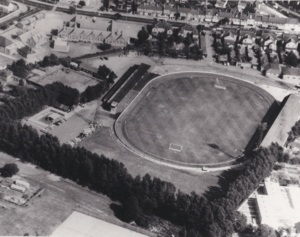City Ground (Cambridge) facts for kids
| Full name | City Ground |
|---|---|
| Coordinates | 52°12′59″N 0°7′21″E / 52.21639°N 0.12250°E |
| Capacity | 2,300 (500 seated) |
| Construction | |
| Built | 1922 |
| Opened | 1922 |
| Closed | 2013 |
| Tenants | |
| Cambridge City | |
The City Ground (also known as Milton Road) was a football stadium and a track for greyhound racing in Cambridge, England. It was the home stadium for the Cambridge City Football Club.
Contents
The City Ground: Home of Cambridge City
The City Ground was the home of Cambridge City Football Club for many years. It was located in the Chesterton area of Cambridge. The stadium was used by the club from April 29, 1922, until April 27, 2013.
Early Days and Big Crowds
When the ground first opened, the club was called Cambridge Town. They played their first game there against Merton Town. The City Ground was one of the biggest stadiums outside of the top professional leagues. It could hold over 20,000 people. The largest crowd ever recorded was 12,058 fans in 1961.
Changes to the Stadium
In the late 1960s, the stadium also started hosting greyhound races. Sometimes, more people came to watch the dog races than the football matches. By 1985, parts of the land were sold for new buildings. The original stadium was taken down, and a smaller, newer ground was built nearby. This new ground was still called the City Ground.
The stadium had space for 2,300 fans. About 500 people could sit in the Main Stand. Across from it, a covered area called "The Shed" was popular with the club's loudest supporters. The ends of the ground, known as the School End and the Westbrook End, were open and had no cover.
Challenges and Moving On
The club faced some tough times with the stadium. The land was sold for much less than it was worth. This led to a legal fight, but the club was able to stay at the City Ground until 2013. They also got a share of any future money from developing the site.
In 2008, the City Ground did not pass an inspection by FA. Because of this, Cambridge City was moved down a league, from the Conference South to the Southern League Premier Division. The club tried to appeal this decision, but it did not change.
The club looked for a new home. They thought about building a new stadium with other local teams. In 2012, the club's president bought land in Sawston to build a new stadium with community facilities.
Cambridge City played their last match at Milton Road on April 27, 2013. They played against Redditch United F.C. Many former players came to celebrate the day. A crowd of 814 watched Adrian Cambridge score the winning goal, making sure City ended their time at Milton Road with a victory. After leaving the City Ground, the club shared a stadium with Histon for a couple of seasons.
Televised Match
In the 2012–13 FA Cup, Cambridge City made it to the First Round. The City Ground hosted its first ever televised match. ESPN showed the game, which was a 0–0 draw against League One team Milton Keynes Dons.
Greyhound Racing at City Ground
Greyhound racing began at Milton Road on October 6, 1968. A track was built around the football pitch for the races. It was known as the Cambridge City Greyhound Stadium. Races were held on Wednesday and Saturday evenings.
Racing Successes
In 1978, the track decided to follow the rules of the National Greyhound Racing Club (NGRC) again. This brought a lot of success. Famous trainers like Pat Mullins joined the track. Pat Mullins won the Scottish Greyhound Derby in 1979 with a dog named Greenville Boy. Another dog, Sport Promoter, became Greyhound of the Year in 1980. Pat Mullins was also named Trainer of the Year that same year.
After Pat Mullins passed away in 1981, his wife Linda took over the kennels. Other trainers like Joe Cobbold and Natalie Savva also brought wins to Cambridge. The track became well-known in the racing world.
End of Racing
The successful period for greyhound racing at Cambridge ended in 1983. The track's NGRC licence was cancelled, and many top trainers left. In 1984, plans were approved to redevelop the entire area. The greyhound track and football pitch were removed. The last greyhound race was held on April 14, 1984. The last football match on the original pitch was on April 25, 1984.


